Proteins
Proteins are referred to as “the building blocks of life” (Protein in Diet Para 1). Protein is required by the body for repair and maintenance. The building blocks for protein are amino acids, whose structure is in the form of long chains. Dietary proteins cannot be directly absorbed from the GIT due to their large and complex nature. They are therefore absorbed in the form of amino acids, which are small and simple molecules. Amino acids are divided into three groups:
- Essential.
- These include histidine, leucine, methionine, threonine, isoleucine, lycine, methionine, tryptophan, phenylalanine and valine.
- Nonessential
- These include alanine, asparagines, aspartic acid and glutamic acid.
- Conditional
- These include glutamine, ornithine, proline, arginine, cysteine, tyrosine, glycine and serine.
Function
Proteins are important constituents of the body tissues and organs. They contribute greatly towards “the structure, function and regulation of body tissues and organs” (What are proteins and do they do Para 3). The amino acid sequence is very important because it defines the function and structure of every protein.
Proteins and their Functions
Antibodies like Immunoglobulin G (IgG)
These bind to certain foreign bodies for example bacteria and viruses. They protect the body from harm.
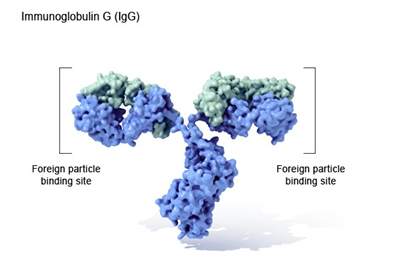
Enzymes like hydrolases
They are the drivers of most chemical reactions in the cells. DNA contains genetic information. Enzymes read this information during the formation of new molecules.
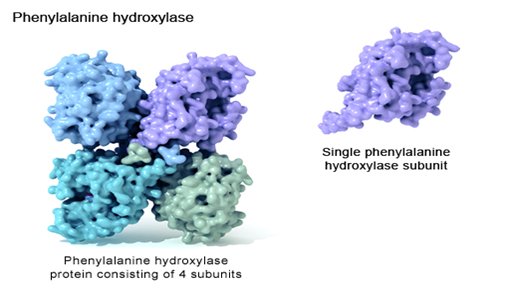
Phenylalanine hydroxylase, which contains four identical subunits converts phenylalanine to tyrosine.
Messengers like hormones
These are involved in the coordination of biological processes by “transmitting signals between cells, tissues and organs” (What are proteins and do they do Para 5).

The growth hormone is produced by the pituitary gland and binds to a growth hormone receptor (a protein) to aid in the regulation of cell growth.
Structure
Proteins are involved in the structuring of cells, and this forms a basis for support. E.g., actin shown below:

The actin filaments help in muscle contraction and maintain the shape of muscle cells.
Transport/ Storage like ferritin for iron storage
They bind to and are carriers of atoms and small molecules in cells and the entire body.

Ferritin consists of 25 subunits
Food Sources
The food sources of proteins include fish, milk, eggs, meat, beans, nut butter, some grains like wheat germ and legumes. A nutritionally adequate protein diet concerning the RDA can meet one’s daily needs for protein.
The various plant sources for protein can meet the protein needs of vegetarians. One’s age and health determine how much protein is necessary.
Age
The daily requirements of proteins for adults are 2 to 3 servings. The myfoodguide pyramid (The Food Guide Pyramid 3) is a good guide to what each serving of protein contains. However, it is worth noting that all protein sources fall under either one of the following food groups:
- Milk and milk products
- Nuts and seeds
- Meat
Protein Digestion
The digestion of proteins starts in the stomach. Gastric juice in the stomach triggers subsequent activities involved in the digestive modification of proteins. It denatures the proteins, triggers the conversion of pepsinogen to pepsin, is involved in the conversion of proteins to easily digestible metaproteins and creates a suitable environment for pepsin due to its pH. Digestion of proteins in the stomach completes with “peptones, proteoses and large polypeptides” as the end products (Protein in diet Para 7). Protein digestion ends in the small intestines by proteolytic enzymes. These are contained in pancreatic and intestinal juices. The end products at the small intestines are amino acids.
Protein absorption is an active process that requires energy, which is obtained from ATP hydrolysis. Protein absorption occurs in the small intestines. Protein is rapidly absorbed in the duodenum as well as in the jejunum. The converse is the case in the ileum (see below).
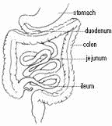
Two mechanisms define amino acid absorption. They are:
Carrier protein transport system

Glutathione transport system (γ Glutamyl cycle)
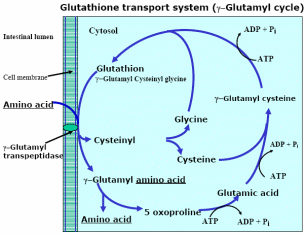
Inadequate Protein Intake
Inadequate intake of proteins leads to “decreased immune function. Poor healing/recovery reduced reserve capacity, longer recuperation from illness, and increased skin fragility” (Chernoff Para 1).
Glucose
Glucose/dextrose is a carbohydrate and essential in human metabolism (Nave Para 1). It is a hexose, aldose, and monosaccharide meaning it is among the smallest units. It is the main source of energy for virtually every body cell including brain cells. It is metabolized into the water, carbon dioxide and nitrogenous compounds in the release of energy (Nave Para 4-5). The following chemical reaction equation indicates how oxidation of glucose takes place:
C6H12O6 + 6O2 –> 6CO2 + 6H2O
Sources
Carbohydrates are either simple or complex. The simple carbohydrates are easily broken down and absorbed into the blood.
Most foods contain carbohydrates, proteins and fats. The amount of nutrients in the food is what determines the rate at which the body converts the food into glucose. Protein-rich foods (discussed in the first section) do not have a major impact on the levels of blood sugar. This is because some of it is stored in the liver without being released into the bloodstream. Fats are also sources of glucose. Less than 10% of fats consumed are converted into glucose (Augustine para 5). This glucose is absorbed into the blood at a slow rate, hence does not lead to an immediate elevation of blood sugar.
Insulin is the hormone required to enable the uptake of glucose into the body cells. If glucose is not being used for energy, it is stored as glycogen in the liver and muscles, or stored as fat as shown below (Iowa State University Extension and Outreach Para 6-7):

Glucose in the blood is very important in the medical world because of its associated effects.
Inadequate intake of Glucose
Inadequate intake of glucose results in dizziness, weakness, and hypoglycemia. A reduction in blood glucose levels during exercise leads to poor performance and mental and physical fatigue.
It is very important to replenish muscle glycogen, failure to which leads to fatigue (Dunford and Andrew 190). The brain uses glucose for its mental activity. Inadequate glucose intake results in a drop of glucose in the brain. A steady supply of glucose to the brain is crucial because neurons are not able to store glucose, therefore lack of continuous replenishment results in adverse effects. The effects of glucose deficit in the brain are a feeling of spaced–out, confusion, nervousness, and inability to focus due to hypoglycemia. The deficit can be so serious to the point that one loses consciousness (Nourish-Carbohydrates Fuel Your Brain Para 22).
Lipids
Lipids are organic constituents in both plants and animals such as wax, fats and oils. They are esters of fatty acids (moderate or long). They are not soluble in water but are soluble in organic solvents. Fats are the lipid form commonly ingested in food. Fats aid in the absorption of fat-soluble vitamins; cushion and protect the heart, kidney and liver by acting as a shock absorber; and prevents loss of heat from the skin by acting as an insulator. Individuals should get the recommended allowances for fats. Age, indicated by the different percentages in the table below as obtained from CDC (Dietary Fat Para 2) affects the allowances for fats.
The rate of carbohydrate digestion is affected by lipids. This is because it slows down carbohydrate digestion and simultaneously slows the rise in blood sugar levels (Augustine, para 6).
Digestion of Lipids
Digestion of lipids begins in the small intestines. This is made possible by the emulsifying salts in bile. Emulsification of fats helps in their digestion because then they can be readily hydrolyzed to glycerol and fatty acids by lipases. Hydrolyzed lipids from the small intestines are absorbed into the bloodstream for transportation to the other organs, especially the liver. In the liver, further metabolism of fat takes place. The ultimate end products of fat metabolism are carbon dioxide and water with the release of energy (The Importance of Fats (Lipids) Para 4).
Sources
The fatty acids define the type of lipid. Depending on the type, there are either saturated, monounsaturated, or polyunsaturated. Animal products for example meat and cheese are good sources of saturated fats. Coconut oil and palm oil are vegetable sources of saturated fats. Olive oil is an example of monounsaturated fats while corn oil is an example of saturated fats.
Inadequate intake
Inadequate intake of fats leads to:
Intramuscular fat stores are poorly replenished
Intramuscular fat stores should be replenished after physical activity. Inadequate replenishment of these stores leads to poor performance and fatigue.
Sex-related hormones are not manufactured
Various studies have shown the relationship between fat intake and the manufacture of sex hormones (Dunford and Andrew 190). One study of healthy men showed that a low-fat diet, consisting of 18 to 25% fat out of the total calories with a lower ratio of saturated to polyunsaturated fats, was associated with reduced testosterone levels.
The ratio of high and low-density lipoproteins is altered
Following the CDC table given above, Dunford and Andrew (190) suggest that the daily intake of fats should not be less than 20% of total calories in a diet. Evidence from research studies indicates that a low-fat diet leads to reduced levels of HDL. This has a detrimental effect on the human body because HDL is a lipid carrier that protects arteries by removing cholesterol and transporting it to the liver for metabolism. This prevents the occurrence of CVD.
There is inadequate uptake of fat-soluble vitamins.
Vegetables
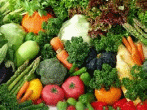
Vegetables are associated with many health benefits that include reducing the risk of CVD and some cancers; decreasing blood pressure; reducing problems of the eyes and digestive tract; and they have a mellowing effect on blood sugar, which prevents suppression of appetite especially in children (Vegetables and Fruits Para 3). Vegetables are obtained from plants. It is important to name vegetables about the parts of the plant they signify. This helps to understand the vegetable better and to speculate on some of its properties. The table below Fruit and vegetable processing Para 6) represents a classification of vegetables, factoring in their morphological features:
Nutrients and Sources
The natural characteristics of vegetables are that they are low in fat and calories and none of them has cholesterol. However, fat, calories and cholesterol may be derived from seasonings or sauces.
With the associated benefits of vegetables given above, an inadequate intake of vegetables leads to the occurrence of chronic diseases. According to WHO (Promoting Fruit and Vegetable consumption around the world Para 1), “14% of worldwide GIT cancer deaths and 11% of deaths as a result of ischemic heart disease and 9% deaths due to stroke” are attributable to an inadequate intake of fruits and vegetables. It is estimated that a worldwide mortality rate of 2.8% is due to an inadequate intake of fruits and vegetables (Promoting Fruit and Vegetable consumption around the world Para 1).
Recommendation
It is very important to maintain a healthy and balanced diet. Every nutrient when taken in appropriate quantities and portion sizes yield maximum health benefits to the body. Below is an ideal illustration of how a plate of food should look like as obtained from “Promoting Fruit and Vegetable consumption around the world”:

Works Cited
Augustine, Jodi. “Sources of Glucose.” Group Health Cooperative, 2012. Web.
Chernoff, Ronnie. “Protein and older adults.” J Am Coll nutr. 23.6 (2004): n. pag. Web.
Dietary Fat. CDC, 2012. Web.
Dunford, Marie, and Andrew Doyle. Nutrition for Sports and Exercise. Belmont: Thomson Higher Education, 2008. Print.
Fruit and vegetable processing. FAO Corporate Document Repository, 1995. Web.
Nave, Carl Rod. “Glucose.” HyperPhysics. Georgia State University, 2012. Web.
Nourish-Carbohydrates Fuel Your Brain. The Franklin Institute, 2004. Web.
Promoting Fruit and Vegetable consumption around the world. WHO, 2013. Web.
Protein in diet. MedlinePlus, 2013. Web.
The Food Guide Pyramid. United States Department of Agriculture, n.d.
The Importance of Fats (Lipids). Diet-and-Health.net, n.d. Web.
Vegetables and Fruits. Harvard School of Public health, 2013. Web.
What are proteins and do they do? Genetics Home Reference, 2013. Web.